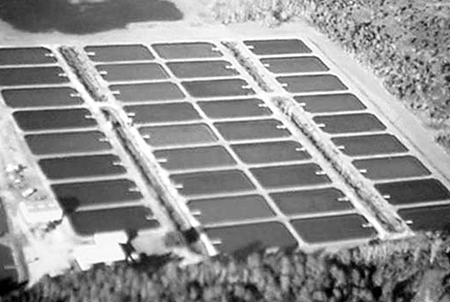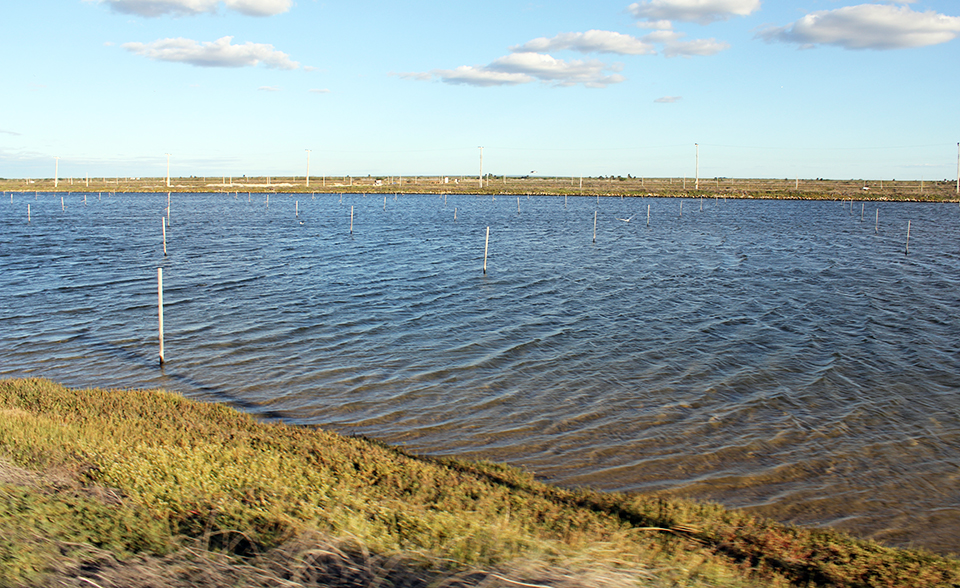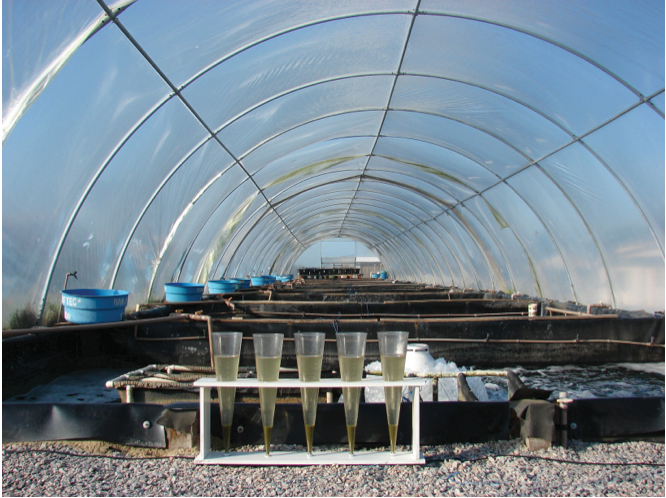Little advantage in recirculation between production, oxidation ponds

A conventional practice to resolve degraded water quality in shrimp aquaculture ponds is to exchange water. During water exchange, pond water with high nutrient and algal concentrations is discharged from a pond, and replaced by water with lower nutrient and algal concentrations and greater dissolved-oxygen concentration. Water exchange as a pond-management tool must be used judiciously, however, because of the potential negative impact effluents can have on receiving waters.
Alabama study
A variety of water-recycling schemes has been proposed. Research at the Claude Peteet Mariculture Center in Gulf Shores, Alabama, USA evaluated changes in the chemical characteristics of production pond water, soils, and shrimp yields in response to water recycling through an oxidation pond. Effects on water quality and shrimp production were minimal using this approach.
Treatments
Three 0.1-ha ponds were stocked with Litopenaeus vannamei at 50 postlarvae per square meter with no water recirculation, while another three received the same stocking but included water recirculation through an adjacent pond of equal volume not stocked with shrimp. Another set of ponds was stocked at 25 postlarvae per square meter with no water recirculation.
Water movement and aeration
Water movement between the ponds using the recirculation set-up was accomplished with one 0.5-hp submersible pump at the deep end of the culture pond, and another at the shallow end of the oxidation pond. Pumps were operated simultaneously 20 hours per day.
All ponds were equipped with oxygen-sensing systems, and a 1.5-kw propeller aspirator aerator. The automatic aerator-activation system in each pond was programmed to maintain a dissolved oxygen concentration of 3.5 milligrams per liter in the pond water.
Shrimp densities and yields
The density of shrimp in the low- and high-density with recycling treatments was equal when based on the total water area of production and recycling ponds. Mean shrimp yields for the low-density, high-density, and high-density recycling ponds were 1,706 kilograms per hectare; 4,648 kilograms per hectare; and 4,534 kilograms per hectare, respectively.
There was no significant difference in yields between the high-density treatments, or between the low-density and high-density treatment with recirculation, when based on total water surface area. Mean harvest weights for shrimp in all ponds ranged 22 to 25 grams.
Nitrogen and water quality
Recycling water through oxidation ponds resulted in significant reductions in the mean mass weight of total nitrogen and total ammonia nitrogen when compared with the high-density ponds without recycling, because the recirculating ponds used twice the water volume (Table 1).

The sum of the mean mass weight for water-quality variables found in the high-density/oxidation pond systems was significantly greater than the mean mass weight in the free-standing high-density ponds, except for nitrate-nitrogen, nitrite-nitrogen and total ammonia nitrogen. No differences were noted for water quality between the ponds without recirculation.
Water exchange alternative
Only limited research has been done on the effectiveness of recycling systems in reducing nutrient loads, and yields are commonly expressed in terms of the culture unit without including the recycling area. It is important to note the recycling system discussed here is different from indoor recirculation systems or those that use settling basins. In settling basins, water is normally held after the production cycle ends and their effectiveness in water-quality improvement has been plainly proven.
Conclusion
In this study, the recycling of water from production ponds through oxidation ponds of equal volume had minimal effect on water quality and shrimp yields. No differences were observed among treatments for soil pH, concentrations of carbon, sulfur, nitrogen, soil respiration and phosphorus absorption capacity.
The major operational disadvantages of recycling water are that pond space is put into non-productive use as oxidation ponds, and 3.3 times more energy is used for aeration and water circulation. A better strategy would be to stock two ponds at half the rate, instead of doubling the volume of water per pond by recycling through an oxidation pond.
(Editor’s Note: This article was originally published in the October 2001 print edition of the Global Aquaculture Advocate.)
Now that you've reached the end of the article ...
… please consider supporting GSA’s mission to advance responsible seafood practices through education, advocacy and third-party assurances. The Advocate aims to document the evolution of responsible seafood practices and share the expansive knowledge of our vast network of contributors.
By becoming a Global Seafood Alliance member, you’re ensuring that all of the pre-competitive work we do through member benefits, resources and events can continue. Individual membership costs just $50 a year.
Not a GSA member? Join us.
Author
-
Oscar Zelaya
Department of Fisheries and Allied Aquaculture
Auburn University
Auburn, Alabama, USA[109,111,99,46,111,111,104,97,121,64,109,122,100,111]
Tagged With
Related Posts

Health & Welfare
10 paths to low productivity and profitability with tilapia in sub-Saharan Africa
Tilapia culture in sub-Saharan Africa suffers from low productivity and profitability. A comprehensive management approach is needed to address the root causes.

Responsibility
A look at integrated multi-trophic aquaculture
In integrated multi-trophic aquaculture, farmers combine the cultivation of fed species such as finfish or shrimp with extractive seaweeds, aquatic plants and shellfish and other invertebrates that recapture organic and inorganic particulate nutrients for their growth.

Health & Welfare
AHPN inferences based on behavior of vibrio bacteria
Vibrio parahaemolyticus, a strain of which is the cause of acute hepatopancreatic necrosis (AHPN), has both virulent and benign strains. This strain colonizes the stomachs of shrimp by the formation of a biofilm, which protects it from antibiotics and other potential treatments.

Health & Welfare
Ammonia addition enhances microbial flocs in nursery phase for Pacific white shrimp
In a study, “pre-fertilization” in the nursery phase of a biofloc system for shrimp was tested. The objective was to accelerate the biofloc formation to minimize ammonia concentrations, avoiding high peaks during culture.


